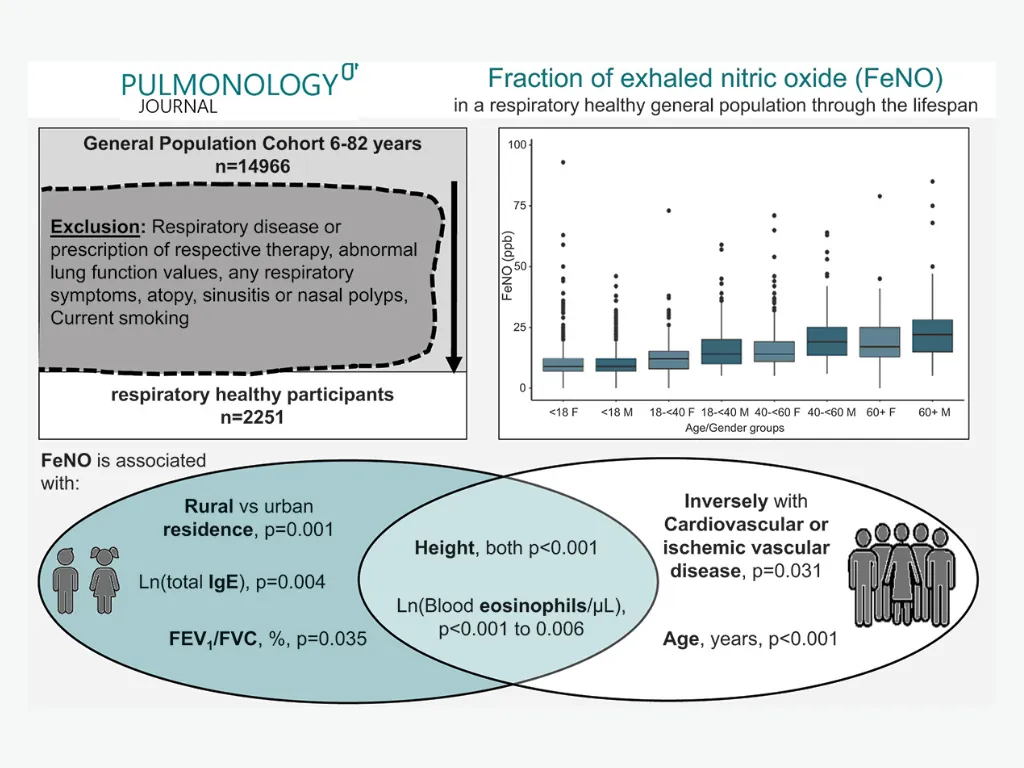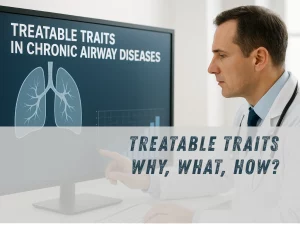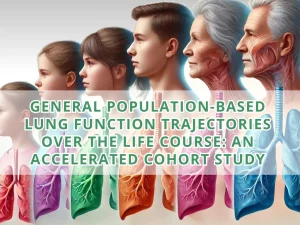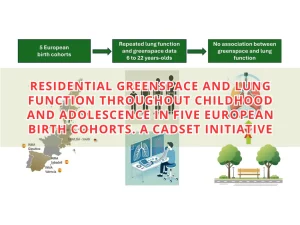Fractional exhaled nitric oxide in a respiratory healthy general population through the lifespan

The Role of Fractional Exhaled Nitric Oxide (FeNO) in Asthma Management. Introduction and Objectives:
The fractional exhaled fraction of nitric oxide (FeNO) is used in clinical practice for asthma diagnosis, phenotyping, and therapeutic management. Therefore, accurate thresholds are crucial. The normal FeNO values over lifespan in a respiratory healthy population and the factors related to them remain unclear.
Materials and Methods: FeNO Measurement in the LEAD Cohort Study
We determined FeNO levels in 2,251 respiratory healthy, non-atopic, and non-smoking participants from the Lung, hEart, sociAl, boDy (LEAD) cohort, a general population, observational cohort study of participants aged 6–82 years in Austria.
ResultsResults: FeNO Ranges and Influencing Factors Across Age Groups
The median FeNO value in the total study population was 13.0 [interquartile range: 9.0, 20.0] ppb, increases with age, and, except in young participants (<18 years: 9.0 [7.0, 12.0], ≥18 years: 15.0 [11.0, 22.0]), it was significantly lower in females versus males.
Multiple regression analyses showed that body height and blood eosinophil counts were associated with higher FeNO levels, both in children/adolescents and adults.
In children/adolescents, FeNO values were positively associated with total IgE levels, FEV1/FVC ratio, and urban living.
In adults, FeNO was positively associated with age and negatively associated with the presence of cardiovascular and ischaemic vascular disease.
Conclusions:
Authors
Christina Bal, Caspar Schiffers, Marie-Kathrin Breyer, Sylvia Hartl, Alvar Agusti, Ahmad Karimi, Wolfgang Pohl, Marco Idzko & Robab Breyer-Kohansal
Read more details at
Fecha de publicación
06 Jan 2025
Categorías asociadas al artículo
Noticias relacionadas

Treatable Traits. Why, What, How?
Discover how the Treatable Traits approach transforms the management of asthma, bronchiectasis, and COPD through personalized precision medicine strategies.

General population-based lung function trajectories over the life course: an accelerated cohort study
Empirical life course lung function trajectories from ages 4–80 using data from eight cohort studies in Europe and Australia.

Residential greenspace and lung function throughout childhood and adolescence in five European birth cohorts. A CADSET initiative
Study of five European cohorts found no association between residential greenness or urban green space and lung function throughout childhood and adolescence.
Artículos
Asthma
- 759578·Alberto Papi et Al.-Relationships between symptoms and lung function in asthma and/or chronic obstructive pulmonary disease in a real-life setting: the NOVEL observational longiTudinal studY
- 759785·Richard Beasley et Al – Prevalence, Diagnostic Utility and Associated Characteristics of Bronchodilator Responsiveness
- 768973·James Fingleton, Rob Mclachlan, Jenny Sparks, Richard Beasley, Alvar Agusti, Peter G Gibson, Ian Pavord, Jo Hardy, Mark Weatherall, Allie Eathorne, Vanessa Mcdonal -Treatable trait guided asthma management: biomarker changes and responder analysis
- 768973·Xander Bertels et Al.- Phenotyping asthma with airflow obstruction in middle-aged and older adults: a CADSET Clinical Research Collaboration
- 769799·Alvar Agusti, Peter G. Gibson, Vanessa M. McDonald. Treatable Traits in Airway Disease: From Theory to Practice
Lung function
- 759688· Prof Eric Melen et Al. – Lung-function trajectories: relevance and implementation in clinical practice.
- 769289·Caspar Schiffers, Rosa Faner, et al. Supranormal lung function: Prevalence, associated factors and clinical manifestations across the lifespan.
- 769491·Tamara Cruz, Núria Mendoza, Gema M Lledó, Lídia Perea, Núria Albacar, Alvar Agustí, Jacobo Sellares, Oriol Sibila, Rosa Faner. Persistence of a SARS-CoV-2 T-cell response in patients with long COVID and lung sequelae after COVID-19
- 769799·Alvar Agusti, Peter G. Gibson, Vanessa M. McDonald. Treatable Traits in Airway Disease: From Theory to Practice
- 778797· Xavier Alsina-Restoy, Rodrigo Torres-Castro, Yolanda Torralba García, Felip Burgos, Joan Albert Barberà, Àlvar Agustí, Isabel Blanco Does arterial oxygenation during exercise add prognostic value in pulmonary arterial hypertension?
Imagen obtenida del artículo y adaptada con Canva
